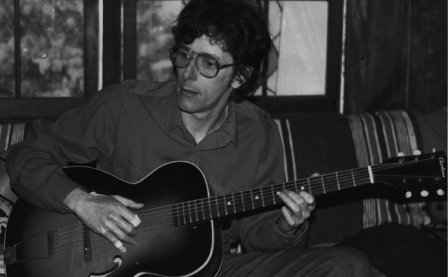Morton Feldman once said, “Where in life we do everything we can to avoid anxiety, in art we must pursue it.” A cursory look at Loren Connors’ oeuvre reveals a like-minded thought process. Similar to fellow New York guitarist Elliott Sharp (with whom he has collaborated), Connors has a colossal back catalog, with over 50 official releases, scores of bootlegs, and still unheard material. The 58-year-old has performed under the Fahey-ish pseudonym of Guitar Roberts, as well as playing in his band Haunted House and collaborating with the likes of Jandek, Alan Licht, Keiji Haino, Thurston Moore, David Grubbs, and Christina Carter.
Connors honed his techniques in the late-’70s squalor of downtown New Haven, developing his remarkable control over the guitar from trying not to agitate his creaky floorboards. It was here where he was exposed to burning plastic, something the guitarist believes led to the onset of his Parkinson's disease in the late-’90s. His unique interpretation of the bottleneck styles reanimates the spectres of Delta bluesmen like Guitar Slim and Blind Lemon Jefferson and recasts their souls upon the altar of outsider experimentation.
Remastered by Jim O'Rourke, As Roses Bow is a collection of material culled from 10 years of full-lengths and one single. The collection focuses on Connors’ “airs,” miniature melodies composed in the tenor range. These collected airs are an homage to the Irish folk music with which he grew up, especially the work of 18th-century blind harpist Torlough O'Carolan. As O'Carolan lay dying, he composed "O'Carolan's Farewell to Music." On this album, the airs are played on Connors' own "harp," a heavily reverbed Stratocaster, evoking a similar finality to O’Carolan's musical epilogue.
Connors’ first foray into the art world was painting in the style of his hero, Mark Rothko. Later, Connors realized that his music was more unique and changed trajectories, though Rothko remained an influence. The painter's immense, monolithic panes of gently cascading hues evoke the mild pathos so evident in Connors’ work. The frailty of Connors’ compositions reveals a frail psyche. The theme of isolation is strong, and each air creates a sense of a foreboding, all-encompassing beauty that is transcendent and sublime.
Commenting on his composition methods, Connors insists that the music is contained within himself and is ultimately realized or let out in an organic process, slowly emerging like sap from a tree. Indeed, Connors’ output has always been minimalist and sparse, with an emphasis on both slow, accentuated tones/drones and a laborious, almost Feldman-ian consciousness of space and sound. As Roses Bow weeds out Connors’ more morose and avant-garde moments, making it one of his most accessible collections to date. It's a great introduction for neophytes wondering where to dive into the vast ocean of the guitarist's work.
More about: Loren Connors




